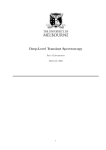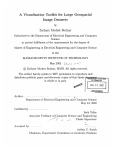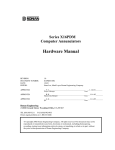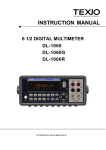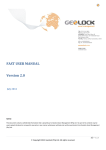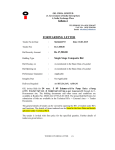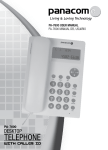Download User Manual
Transcript
User Manual (11) Display for the selected function (12) Display for the unit of measured quantity. (13) Over range indication for positive analog range. (14) Pointer for analog indication. (4) Pushbutton for manual range (15) Scale for analog indication selection (16) Over range indication for (5) Multi function pushbutton negative analog range. (17) Low battery indication. (6) Function selector switch. (18) Buzzer indication (19) Display 0C for temperature (7) Terminal sockets measurement range. (8) Symbol for ’’CONTINUOUSLY ON" (20) Rotary mechanism for clamp jaws. (21) Safe trigger mechanism. (9) Display for digits, decimal point and polarity. (10) Display for manual range selection, data HOLD and MIN/MAX storage. (1) (2) (3) Liquid crystal display ON/OFF pushbutton Pushbutton for data hold and MIN/MAX storage functions Contents 1. 2. Page Introduction ............................................................................ 2 Safety features and safety precautions ........................................... 2 3. Switching the Clampmeter "ON" ..................................................... 3 4. Function and range selection .......................................................... 4 4.1 Autoranging ............................................................................ 4 4.2 Manual range selection ....................................................................4 5 Liquid crystal display ....................................................................... 5 5.1 Digital display ............................................................................ 5 5.2 Analog indication .............................................................................5 5.3 Backlit .............................................................................................5 6. Data “HOLD” facility ..................................................................... 6 7. Minimum value and maximum value "MIN/MAX storage facility. ........... 6 8. Voltage measurement .....................................................................9 8.1 Voltage measurement on electrical system upto 1000V with the KS30 measuring adapter .................................................. 9 9. Resistance measurement ...............................................................11 10. Diode test and continuity test ..........................................................11 11. Temperature measurement ........................................................... 12 12. Capcacitance measurement ........................................................ 12 13. Frequency measurement .............................................................13 14. Duty cycle measurement .................................................................13 15. AC Current measurement ..............................................................14 16. Empty Positions .......................................................................... 16 17. Specifications .................................................................................. 17 18. Maintainance ................................................................................21 18.1 Battery .........................................................................................21 18.2 Periodic Check-up : ....................................................................22 19. Servicing .......................................................................................22 1. Introduction: Thank you very much for selecting . LUMEL S.A. is the leading manufacturer of Electrical and Electronics state-of-art measuring instruments. These clamp meters are manufactured as per IS 13875 and DIN 43751 I 2. Safety features and safety precautions You have chosen a Clamp meter which provides you a very high degree of safety. The digital clamp meter NC10 300A/1000A manufactured and tested in compliance with the safety standard IEC 61010-1:2001 / DIN EN 61010-1:2001. In case of incorrect use or careless handing, the safety of both user and clamp meter is not assured. For proper use and safe handling,it is absolutely necessary to read and understand the operating instructions before using the clamp meter. Please note the following safety precautions: The clamp meter must be operated only by persons who understand the danger of shock hazards and are aware of the necessary safety precautions. Shock hazards exist wherever voltages of more than 30V (TRMS) are present. Do not work alone in shock hazardous environment while carrying out measurement. The maximum permissible voltage between any of the terminal sockets (7) and ground is 1000V. Take into account that unexpected voltages can occur on device under test (e.g. defective instrument). For example, capacitors may be charged to a dangerously high voltage. Verify that the test leads are in good condition, e.g.no cracked insulation, no open circuits in the leads or connectors. This clamp meter must not be used for measurements on circuits with corona discharge (high voltage). Be particularly careful when measuring on HF circuits. Dangerous composite voltages may exist there. Measurements under moist environmental conditions are not permitted. Do not overload the measuring ranges beyond their allowable capacities. Limit values are given in specifications. Ref. Chapter 16. For safe voltage measurements in power systems upto 1000V, we recommend the KS30 measuring adapter, which is available as an accessory. Its internal resistance limits the measuring current in the case of overvoltage, in correct operation and safely suppresses sparking from spark gap. Also refer to Section "8.1 Voltage measurement on electrical systems up to 1000V with KS30 measuring adapter. Meaning of categories and their significance per IEC 61010-1 CAT I: Measurements in electrical circuits which are not directly connected to the mains: for example electrical systems in motor vehicles and aircraft, batteries etc. circuits CAT II: Measurements in electrical which are electrically connected to the low-voltage mains:with plugs, e.g. at home, in the office or laboratory etc. CAT III: Measurements in building installations, stationary power consumers, distributor terminals, devices connected permanently to the distributor CAT IV: Measurements at power sources for low-voltage installations, meters, mains terminals, primary over voltage protection devices. Meaning of the symbols on the device Warning of a danger point (Attention, refer to the user manual) Earth (ground) terminal. Double or reinforced insulation CAT III / IV Instrument for over voltage category II/III OR IV Meaning of the acoustic signals 1) Intermittent acoustic signal: Voltage limit exceeded; for Voltage>1000 V 2) Intermittent acoustic signal: Current limit exceeded; for Current>1100 A Repair, replacement of parts: When opening the meter, live parts may be exposed. Therefore, the meter must be disconnected from the measuring circuit prior to opening its case for repair or replacement of parts. If repair cannot be avoided unless the meter is opened and live, this work must only be performed by a qualified person who understands the danger involved. Faults and abnormal stress: When it is realised that the safe operation is no longer possible, take the meter out of service and secure it against accidental use. Safe operation may not be possible, when the meter shows obvious signs of damage, when the meter no longer functions correctly, after prolonged storage under adverse conditions, due to severe stress during transportation. 3. Switching the Clamp meter "ON" Battery We have already fitted your meter with a 9 V flat cell battery according to IEC 6 F 22 or IEC 6 LR 61. It is ready for operation. Before you use the meter for the first time or after storage, refer to Section "18.1 MaintenanceBattery". Switching the meter "ON" Press the "ON/OFF" pushbutton (2). Switch-"ON" is acknowledged by a sound signal. As long as you keep the pushbutton pressed, all segments of the liquid crystal display (LCD) will appear. The LCD is shown behind cover page After the pushbutton is released, the meter is ready for operation. Note: Electric discharges and high-frequency influence may cause incorrect information to be displayed and block the measuring process. Reset the meter by switching it OFF and ON again otherwise, check the battery connections. Disconnect the clamp meter from the measuring circuit before you open it, and see section "18. Maintenance" ! Automatic TURN-OFF The meter turns off automatically, when the measured value remains constant (variations of the measured value < + 2digits) for about 10 minutes and when neither a pushbutton nor the function selector switch is operated during that time. How to prevent automatic TURN-OFF In order to prevent automatic "TURN OFF" select "CONTINUOUSLY ON" mode. For this, press yellow multi-function pushbutton (5) and the "ON/OFF" pushbutton (2) together. The function "CONTINUOUSLY ON" is shown on the LCD (1) by the symbol ON (8). Turning the multimeter OFF Press the "ON/OFF" pushbutton (2). 4. Function and range selection 4.1 Autoranging The multimeters feature autoranging for all measuring ranges with the exception of the 30 mV , 300 mV ranges. Autoranging is Automatically selected after switching the multimeter ON. According to the measured quantity applied, the multimeter automatically selects the measuring range which gives the best resolution. When switching to frequency measurement and ratio measurement the previously selected voltage measuring range is maintained. The meter switches automatically to : the next higher range at + (3099 digits + 1 digit) the next lower range at + (240/280 digits - 1 digit) 4.2 Manual range section You can switch OFF autoranging and select the ranges manually according to the table on the following page. Manual mode is switched OFF when pushbutton AUTO/MAN is pressed (4) for approximately 1s, when the function selector switch (6) is operated, or when the meter is turned OFF and ON again. When switching back to autoranging from 30 mV or 300 mV ranges, 3 V range is automatically selected. F 30 nF 300 nF 3 μF 30 μ F 30 nF... 300 Hz 3 KHz 30 KHz 100 KHz 300 Hz... 300A 1000A 300A ... NC10 1000A A 30A 300A 30A ... NC10 300A A Hz . . 5. Liquid crystal display 5.1 Digital display The digital display (9) shows the measured value with correct location of decimal point and sign. The selected measuring Unit (12) and the function (11) are simultaneously displayed. When measuring DC quantities, a minus sign appears in front of the digits, when the positive pole of the measured quantity is applied to the " " input terminal. When upper range limit 3099 : 1999), is exceeded then "OL" is displayed. ( on the range With V and measurements, the digital display is updated two times per second. A A 5.2 Analog indication The analog indication with pointer presentation gives the dynamic response of a moving-coil movement and is updated 20 times per second, when measuring Vand . Analog indication is of particular advantage when observing variations of measured values and for calibration procedures. The analog indicator has its own polarity indication. When measuring DC quantities, the analog scale (15) has a negative range of 4 scale divisions so that variations of the measured values around "zero"can be observed exactly. When the measured value exceeds the range of indication, the left triangle (16) is shown before the polarity of the analog indicator switches over after approximately 0.7s. The over range indication on the measuring range (> 3099 digits, on the range >1999) is shown by the right triangle (13). The instrument is provided with user selectable Back-lit for taking measurements in poor lighting conditions / dark areas. Switching the Backlit ON by pressing "AUTO/MAN" and "HOLD" keys simultaneously the Backlit can be switched ON. Switching the Backlit OFF by pressing "AUTO/MAN" and “HOLD" keys simultaneously the Backlit can be switched OFF. 6. Data “HOLD” facility The HOLD function allows to automatically hold the measured values. The meter holds the measured value on the digital display with a sound signal and displays “HOLD” on LCD display(10). The probes or clamp can now be removed from the measuring point and the measured value on the digital display (9) can be read. The analog indication is not influenced by the data HOLD. The actual measured value can still be noted / read. Note that with a held digital display, the location of the decimal point is also held. With autoranging selected, the measuring range of the analog indicator is no longer known. Note: Hold function is not available in functions ranges in function V . 0 , C and 30mV and 300 mV To activate “HOLD” function momentarily press the HOLD key. As long as the data HOLD function is active, manual range selection is not possible. The data HOLD function is switched OFF, when, The "HOLD” pushbutton (3) is pressed for approx. 1s. This is acknowledged by 2 sound signals. The function selector switch (6) is operated or The multimeter is turned OFF and ON again. 7. Minimum value and Maximum value ’’MIN/MAX" storage facility. With the MIN/MAX function, you can hold the minimum and the maximum measured value which was applied to the input of the multimeter after activating MIN/MAX function. The most important application is the determination of the minimum and the maximum value for long-term monitoring of measured quantities. MIN/MAX does not influence the analog indication The actual measured value can still be noted/read. Apply the measured quantity to the meter and select the measuring range prior to activating the MIN/MAX function. With the function activated, you can select the measuring ranges only manually, if you switch to another range, the stored MIN/MAX values are cleared. Function MIN / MAX MeasDATA uring MIN / MAX ranges (3) Measured Values MIN and MAX Meter acknowledgement Display Meas. MIN Sound Value digital MAX Signal 1. Activate and Store 2 x Short, 30 mV/ 300 mV and 0C 1 x short 2. Store and display short 3. Return to 1. Short Same as 1., Same Stored Values are same as 1. as 1. not cleared Reset Long Cleared short actual measured value stored Storage Continued MIN in the background, value new MIN / MAX. stored values are displayed MAX value Stored MIN and MAX flash 1x MIN 1x MAX 1x same as 1. 1x Cleared Cleared 2x The MIN/MAX function is switched OFF, when the MIN/MAX pushbutton (3) is pressed for approximately 1s, or when the function selector switch (6) is operated, or when the meter is turned OFF and ON again. Voltage measurement Voltage measurement on electrical systems up to 1000 V with the KS30 measuring adapter 8. Voltage measurement According to the voltage to be measured , set the function selector V switch (6) to V Connect the test leads as shown. The ’’ ’’ socket should be connected to the lowest potential ground available. ~, Notes : The 30 mV and 300 mV measuring ranges can only be selected manually with the ’’ AUTO/MAN ’’ pushbutton (4) ! On the 1000 V range, an intermittent sound signal warns you, when the measured value exceeds the upper range limit. Zero adjustment on the 30 mV measuring range Connect the test leads to the meter and join the free ends. After having selected the measuring range, briefly press the yellow multifunction pushbutton (5). The meter acknowledges zero setting by a sound signal, the LCD shows ’’00.00’’ (+ 1 digit) and the decimal point flashes. The displayed voltage at the instant the pushbutton is pressed, is used as reference value (max + 200 digits) it is automatically deducted from the values measured thereafter. The zero adjustment is cleared when ; By pressing the yellow multifunction pushbutton (5) for a long time, clearance is acknowledged by the two sound signal. By switching the instrument OFF. 8.1 Voltage measurement on electrical systems up to 1000V with the KS30 measuring adapter. On low-Voltage systems, transient overvoltages of several kilovolts can occur due to switching functions or lightning discharges. Direct connection of your multimeter to such systems for voltage measurement can be dangerous. For voltage measurements in power systems with nominal voltages upto 1000V, use the KS30 measuring adapter. It is an adapter for multimeter which eliminates dangers caused by overvoltages and incorrect operation of the multimeter. It provides the following protective functions.. Protection of the input circuit of voltage measuring range of multimeters. The internal resistance of the KS30 limits the current in the case of overvoltage. Overload capacity : continuously 1200 Vrms Safe suppression of sparking from spark plug after overvoltage. Voltages above 1000V can be measured with a high-voltage probe, provided the necessary safety precautions are taken ! Resistance measurement Diode Test Forward direction Reverse direction Continuity Test 9. Resistance measurement Verify that the device under test is electrically dead. External voltages would falsify the measured result ! Set the function selector switch (6) to " ". Connect the device under test as shown. Zero adjustment on the 30 measuring range When measuring small resistance values on the 30 range, you can eliminate the resistance of the leads and contact resistance by zero adjustment. Connect the test leads to the multimeter and join the free ends. Briefly press the yellow multi-function pushbutton (5). The meter acknowledges zero adjustment by a sound signal, the LCD shows "00.00" (+1digit) and the decimal point flashes.The resistance measured at the instant the pushbutton is pressed is used as reference value (max.200 digits) It is automatically deducted from the values measured thereafter. Zero adjustment can be cleared. By pressing the yellow multifunction pushbutton (5) for a long time and is acknowledges by two sound signals. By switching the multimeter OFF. 10. Diode test and continuity test Verify that the device under test is electrically dead. External voltages would falsify the measured results ! Set the function selector switch (6) to " " connect the device under test as shown. Forward direction and/or short circuit: The multimeter displays the forward voltage in Volts. As long as the voltage drop does not exceed the maximum display value of 1.999V, you can also rest several series-connected elements or reference diodes with small reference voltage. Reverse direction or open circuit: The multimeter indicates overrange "OL" Note: Resistors and semiconductor junction in parallel with the diode falsify the measured results! Diode test and continuity test with buzzer With the "buzzer" function selected, the meter emits a continuous sound signal on the range 0...approx. 0.2 V. To switch the buzzer ON: Briefly press the yellow multi-function pushbutton (5). The multimeter acknowledges turn-ON with a sound signal. At the same time, the symbol (18) appears on the LCD. To switch the buzzer OFF Briefly press the yellow multi-function pushbutton (5) again. The multimeter acknowledges turn-OFF with a sound signal. The symbol (18) disappears from the LCD. When selecting the function "Diode test and continuity test’’ with the function selector switch (6), the buzzer is always switched OFF. Repeated brief pressing of the multifunction pushbutton (5) alternately switches the buzzer on and off. When pressing the push button for a long time, the buzzer is al ways switched OFF, this is ack n owledged by the buzz er sounding twice. 11. Temperature measurement The NC10 300A / 1000A allows you to measure temperature with Pt 100 and Pt 1000 temperature sensors in the range from - 200 (- 100)0C...+8500C. Set the function selector switch (6) to " ". Connect the sensor to the two terminals. Briefly press the yellow multifunction pushbutton (5). The multimeter switches to temperature measurement, it automatically detects the connected sensor (Pt 100 to Pt 1000) and shows the measured temperature in 0C on the digital display. . Notes: This measurement automatically considers the lead resistance of RISHABH temperature sensors which are available as accessory. It is not possible to switch over to temperature measurement when the 30 resistance range is selected. Sensor lead resistance up to 50 Lead resistance of sensors having a value differing from that of our sensors can be considered up to a value of 50 as follows: Briefly press the yellow multi-function pushbutton (5) again. The LCD now displays the resistance value which the multimeter automatically considers after selecting the temperature measuring range. We can recognise that this is the resistance correction value on the temperature measuring range. The ’’ 0C’’ character is simultaneously shown on the display. You can set the lead resistance correction value as follows: Press the HOLD pushbutton (3) to increment the value, or the AUTO/MAN pushbutton (4) to decrement the value. Each time the pushbutton is briefly pressed, the value changes by one digit. Briefly press the yellow multi-function pushbutton (5) again. The LCD displays the measured temperature. The flashing decimal point shows you that we have entered a correction value for the lead resistance. The correction value is retained as long as multimeter is switched on. Each time the yellow multi-function pushbutton (5) is briefly pressed, the display changes between measured temperature and correction value of the lead resistance. We can exit the temperature measurement function by pressing the yellow multi-function switch (5) longer, this is confirmed by the two sound signals. by changing the function selector switch. Note: For the lead resistance, the actual value measured on the clamp meter should be taken as correction value and not any specified value. 12. Capacitance measurement Verify that the device under test is electrically dead. External voltages would falsify the measured results. Set the function selector switch (6) to 'F' Connect the (discharged!) device under test to the “ ” and “F' socket via test lead. Notes: Connect polarized capacitors with the “_” pole to the “ ” socket Resistors and semiconductor junction in parallel with the capacitor falsify the measured results! Zero adjustment on the 30 nF measuring range When measuring small capacitrance values on the 30 nF range, the internal resistance of the multimeter and the capacitrance of the leads can be eliminated by zero adjustement. Connect the test leads to the meter without device under test. Briefly press the yellow multi-function pushbutton (5) diplaying “00.00”(+1 digit) on the LCD and by a flashing decimal point. The capacitance measured at the instant the pushbutton is pressed is used as reference value (max.200 digits). It is automatically deduced from the values measured thereafter. Zero adjustment can be cleared By pressing the yellow multi-function pushbutton (5) for a long time clearance is acknowledged by the two sound signal. By switching the multimeter off. 13. Frequency measurement Frequency measurement is possible on all voltage measuring ranges in AC and DC modes. Set the function selector switch (6) to v~,vConnections are made the same way as for voltage measurement. Briefly press the yellow multi-function pushbutton (5) The multi meter switches to frequency measurement. The frequency is displayed on the LCD. See section “16. Specifications” for the lowest measurable frequencies and the maximum permissible voltages. Changing over between voltage,frequency and duty cycle measurement. Repeated brief pressing of the yellow multi-function switch (5) changes the measuring function in the following order: Voltage Frequency duty cycle Voltage… From frequency or duty cycle measurement,directly switching back to voltage measurement is possible. By pressing the yellow multi-function pushbutton (5) for a long time. The meter acknowledges this by tow sound signals. The voltage measuring range last selected is maintained. By operating the function selector switch(6). 14. Duty Cycle measurement With duty cycle measurement, we can determine the ratio of pulse duration to cycle time of recurring square-wave signals. Set the function selector switch (6) to V~ or VConnections are made in the same way as for voltage measurement Briefly press the yellow multifunction pushbutton (5) twice. The meter switches to dutycycle measurement. The duty cycle that is the percentage pulse duration of a signal is displayed on the LCD in % That is: Pulse duration Duty cycle (%) = ------------------------ X 100 Cycle duration Notes : Input applied frequency must remain constant during the duty cycle measurement. Change-over between voltages,frequency and duty cycle factor measurement is done as described in the preceding section. 15. AC Current measurement NC10 1000A can measure current upto 1000 A, in two ranges i.e. 300.0A and 1000 A. Where as NC10 300A can measure current up to 300 A in two ranges i.e. 30.00A and 300.0 A. One of the two ranges can be selected manually with AUTO/MAN key. To measure the current through a cable, push the trigger(21) to open the jaws and clamp the jaws around the cable as shown in . . Figure a Figure b Unique design for safety and comfort Rotary mechanism for clamp jaws: In conventional clamp meters display, keys and clamp jaws are in the same plane. When current measurement is to be done on vertical bus bars, over head cables, cables in congested places user connect the clamp meter but the keys and display may not be visible, hence not able to take the readings or operate the keys. To over come the above mentioned problem NC10 300A/1000A has a unique feature called ‘‘Rotary mechanism for clamp jaws’. In this, the clamp jaws are rotating. Hence it is possible to align the clamp jaws as the orientation of bus bar/conductor while keeping Display and keys facing the user, so that user can take the readings and operate the keys. . Rotary clamp jaws can be rotated at different angles with the step of 30º, maximum up to 90º in both clock-wise as well as anti-clock wise direction as shown in figure c. Figure c Figure d Normally, it is difficult to access the middle busbar for current measurement. With ‘Rotary mechanism for clamp jaws’ it is easy to access middle bus bar, while keeping display and keys facing towards the user as shown in figure d on previous page. Safe trigger mechanism The conventional clamp meters have trigger mechanism either near to left jaw or right jaw. While taking measurements on bare bus bar or bare conductor the user’s hand comes very close to bare bus bar/conductor, which increases the risk of electric shocks to the user. Also in conventional clamp meters trigger is operated with single finger, usually a thumb which causes fatigue to the user while opening or closing the clamp jaws. To over come the above mentioned problems, NC10 300A/1000A has a unique feature called ‘Safe trigger mechanism’ in which trigger is located at bottom side of the clamp meter and far away from the jaws and hence the bus bar. . So user’s hand is at safer distance from bare conductors, hence minimizes the risk of electric shock to the user. This is shown in figure e. Also trigger can be comfortably operated with more than one finger which eliminates fatigue to the user. 55 mm Figure e: User’s hand is at safer distance from bare bus bar/conductor. 16. Empty Positions Empty positions on dial indicates no function is available on these positions. The digital display will look like as in figure below. There are three empty positions present on the dial. 17. Specifications MeasResourement Measuring Range lution Function 30.00 mV 300.0 mV V Input impedance > 10 G > 10 G 40 pF 0.5 + 3 2) 100 mV 40 pF 0.5 + 3 10 mV 3.000 V 1 mV 11 M 40 pF 0.25 + 1 30.00 V 10 mV 10 M 40 pF 0.25 + 1 300.0 V 100 mV 10 M 40 pF 40 pF 40 pF 40 pF 40 pF 40 pF 0.25 + 1 0.35 + 1 0.75 + 2 (10...300 Digit) 0.75 + 1 (>300 Digit) V~ 1000 V 1V 10 M 3.000 30.00 300.0 1000 V V V V 1mV 10mV 100 mV 1V 11 M 10 M 10 M 10 M Overload capacity 1) Intrinsic error of digital display + (...% of rdg. + ... digits) at reference conditions Overload Overload Value duration 1000 V DC Contin- AC uously eff/rms sine wave No load voltage 30.00 10 m 300.0 100 m 3.000 30.00 1 10 300.0 100 3.000 1k 10 k 30.00 2.000 V 300.0 A 1000 A 30.00 A 300.0 A A~ 0 pt 100 C pt 1000 F Hz % -200.0... + 200.0 0C max. 3.2 V max. 3.2 V max. 1.25 V 1 mV 0.1 A 1A 0.01 A 0.1 A 0.1 0C + 200.0... + 850.0 0C 0.1 0C - 100.0... + 200.0 0C 0.1 0C + 200.0... + 850.0 0C 0.1 0C 0.5 + 32) 0.4 + 1 max. 1.25 V max. 1.25 V 0.4 + 1 max. 1.25 V max. 1.25 V max. 3.2 V 0.6 + 1 --------------------Discharge Resistance U 0 max _ _ 1000 V 0.5 + 3 DC 10 min 0.4 + 1 2.0 + 1 0.25 + 1 1.5 + 5 1.5 + 5 1.5 + 5 1.5 + 5 1100 A 2 Kelvin3) + 5 Digit _ 1.0 + 53) _ _ 2 Kelvin + 2 Digit 3) _ _ 30.00 nF 10 pF 2.5 V 2.5 V 3.000 μ F 100 pF 1 nF 30.00 μF 10 nF 2.5 V 2.5 V 300.0 Hz 0.1 Hz 1 Hz 45 Hz 3.000 KHz 1 Hz 1 Hz 45 Hz 45 Hz 30.00 KHz 10 Hz 10 Hz 100.0 KHz 100 Hz 100 Hz 100 Hz 2.0....98.0 % 0.1 % 2 Hz _ Continuously 330 A _ 300.0 nF AC eff/rms sine wave 1.0 + 2 1000 V DC/ 10 min AC eff/rms sine 3) 1.0 + 3 4) 1.0 + 3 1.0 + 3 3.0 + 3 1000 V DC/ Continuously AC eff/rms sine 4) 0.5 + 1 2 Hz...1 KHz ±5 digits 5) 5) <= 3KHz; 1000 V Continuously <=30 KHz; 300 V <= 100KHz 30 V 1 KHz...10KHz; ± 5 Digts/KHz 1) At 0 0... + 40 0C 2) With zero adjustment, without zero adjustment + 35 digits 3) Without sensor 4) 3 V UE= 1.5V eff/rms... 100 V eff/rms 30 V UE= 15V eff/rms... 300 V eff/rms 300 V UE=150 V eff/rms... 1000 V eff/rms 5) On the range 3V ,Square wave signal positive on one side 5...15 V, f=const.,not 163.84 Hz or integral multiple Reference conditions Ambient temperature : + 23 0C + 2 K Relative humidity : 45% ... 55 % RH Frequency of measured quantity 45Hz ...65 Hz Waveform of the measured quantity sinusoidal Battery voltage 8 V + 0.1 V Influence quantity Range of Influence Measured quantity/ Measuring range Variation 1) + (...% of rdg. + ... digits) 1) With Temperature : Error data apply per 10K change in temperature With Frequency : Error data apply to a display from 300 digits on wards 2) With zero adjustment 3) With unknown waveform (crest factor CF>2),measure with manual range selection 4) With exception of sinusoidal waveform. Response time (after manual range selection) Response time Measured quantity/ measuring range of analog indication V ,V~ A~ of digital display 0.7 s 1.5 s 1.5 s 4s 2s 0.7 s 1.5 s μ F, 0C Transient response for step function of the measured quantity 5s from 0 to 80 % of upper range limit from OO to 50 % of upper range limit Max. 1...3 s 300 Hz,3 KHz Max. 2 s 30,100 KHz Max. 0.7 s % (1Hz) Max. 9 s % (>=1Hz) Max. 2.5 s from 0 to 50 % of upper range limit Ambient conditions Functional temperature range -10 C...+ 50 C Storage temperature 0 0 range -25 C...+70 C without batteries Altitude up to 2000 m Mechanical configuration Dimensions Weight 90mm(W) x 270 mm(L) x 70 mm(H) 600 g approx.,including battery 18. Maintenance Caution Disconnect the meter from the measuring circuit before you open it to replace the battery ! 18.1. Battery Prior to initial start-up, or after storage of clampmeter, verify that the battery of clamp meter does not leak. Repeat this check in regular short intervals. If the battery leaks, completely remove the battery electrolyte carefully with a moist cloth and install a new battery before you operate clamp meter again. When the symbol " " (17) flashes on the LCD (1) replace the battery as soon as possible. Measurement can be done, but a reduced measuring accuracy must be taken into account. The multimeter operates with a 9 V flat cell battery according to IEC 6 F 22 or IEC 6 LR 61 or with a suitable NiCd storage battery. Attention ! Disconnect the instrument from the measuring circuit before opening battery cover to replace the batteries. Replacing the battery Place the clamp meter on its face. Loosen the screw of battery cover Which is at rear bottom side of meter. Remove battery cover by Sliding it to bottom side. Remove the battery from the battery compartment and carefully disconnect battery connectors. Snap the battery connectors to a new 9 V battery and insert the battery into the battery compartment. Replace the battery cover by fitting it into slots on battery compartment Tighten the battery cover with the screw. Please destroy the batteries in an environment friendly way. 18.2. Periodic Check-up: The clamp meter does not require any specific maintenance. The surface between opening jaws should be cleaned with dry cloth before operating. Avoid use of cleansers, abrasives or solvents. NC10-07 "LUMEL" S.A. ul. Słubicka 1 65-127 Zielona Góra - Poland tel.: (48-68) 45 75 100 (exchange) fax: (48-68) 45 75 508 e-mail: [email protected] Export Department: Tel.: (48-68) 45 75 302 or 304 Fax: (48-68) 325 40 91 e-mail: [email protected]


























